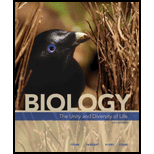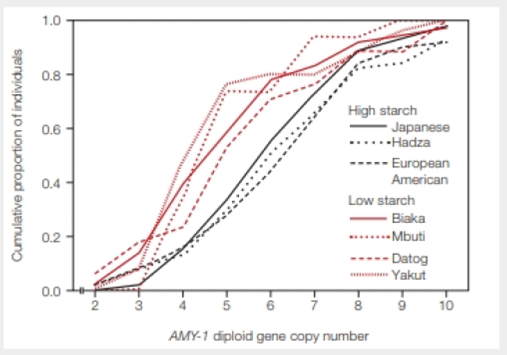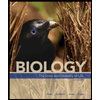
Concept explainers
Human Adaptation to a Starchy Diet The human AMY-1 gene encodes salivary amylase, an enzyme that breaks down starch. The number of copies of this gene varies, and people who have more copies generally make more enzyme. In addition, the average number of AMY-1 copies differs among cultural groups.
George Perry and his colleagues hypothesized that duplications of the AMY-1 gene would be selectively advantageous in cultures in which starch is a large part of the diet. To test this hypothesis, the scientists compared the number of copies of the AMY-1 gene among members of seven cultural groups that differed in their traditional diets. FIGURE 39.9 shows their results.

FIGURE 39.9 Number of copies of the AMY-1 gene among members of cultures with traditional high-starch or low-starch diets. The Hadza, Biaka, Mbuti, and Datog are tribes in Africa. The Yakut live in Siberia.
Starchy tubers are a mainstay of Hadza hunter–gatherers in Africa, whereas fishing sustains Siberia's Yakut. Almost 60 percent of Yakut had fewer than 5 copies of the AMY1 gene. What percentage of the Hadza had fewer than 5 copies?
To determine: The percentage of Hadza people who had fewer than five copies of AMY1 gene.
Introduction: An enzyme present in the saliva that initiates or mediates the hydrolysis of starch into simpler sugar molecules is called as salivary amylase. AMY-1 is the gene that encodes for the salivary amylase enzyme. Humans possess this gene, but copy number of that particular gene highly depends on their dietary habits. Varied number of the copy numbers of AMY1 genes is observed among the people. The people consuming high starchy diets have more copies of AMY1 gene when compared those with less starchy diets.
Explanation of Solution
Refer figure 39.9 “Number of copies of AMY-1 gene among members of cultures with high-starch or low-starch diets” in the textbook. It gives the information about cumulative proportion of individuals versus AMY-1 diploid gene copy number found in them. The variations in copy numbers of the salivary amylase (AMY-1) gene was tested among peoples of seven traditional groups that differ in their traditional food habits. They chose individuals with high starchy diet (Hadza, European American, and Japanese) and with low starchy diet (Yakut, Mbuti, Biaka, and Datog). Researchers observed a great difference in the enzyme copy number in the individuals of different populations.
Hadza are the hunter-gatherers (the people who follow hunting patterns for living instead of farming) in Africa. Their dietary habits include nuts, fruits, roots, berries, grasses, honey, seasonal vegetables, and also meat from animals. Because of high starch consumption, Hadza people possess high copy number of salivary enzyme, whereas, the Yakut tribes from Siberia mostly consume proteinaceous foods such as meat, fish, and milk. Therefore, most probably the salivary enzyme copy numbers will be lesser in the population of Yakut people.
From the given data shown in figure 39.9, almost 60% of Yakut had fewer than five copies of gene because they consume less starchy food. From the given graph, it can be materialized that approximately 30% of the Hadza population had fewer than 5 copies of the AMY-1 gene. The rest of the Hadza population about 70% of people had above 5 copies of AMY-1 gene. This is because of the high starch consumption habits followed among the Hadza population.
Want to see more full solutions like this?
Chapter 39 Solutions
Biology: The Unity and Diversity of Life (MindTap Course List)
Additional Science Textbook Solutions
Prescott's Microbiology
Loose Leaf For Integrated Principles Of Zoology
Biological Science
Biology: Life on Earth (11th Edition)
Fundamentals of Anatomy & Physiology Plus Mastering A&P with eText - Access Card Package (10th Edition) (New A&P Titles by Ric Martini and Judi Nath)
Microbiology Fundamentals: A Clinical Approach
- Human Adaptation to a Starchy Diet The human AMY-1 gene encodes salivary amylase, an enzyme that breaks down starch. The number of copies of this gene varies, and people who have more copies generally make more enzyme. In addition, the average number of AMY-1 copies differs among cultural groups. George Perry and his colleagues hypothesized that duplications of the AMY-1 gene would be selectively advantageous in cultures in which starch is a large part of the diet. To test this hypothesis, the scientists compared the number of copies of the AMY-1 gene among members of seven cultural groups that differed in their traditional diets. FIGURE 39.16 shows their results. FIGURE 39.16 Number of copies of the AMY-1 gene among members of cultures with traditional high-starch or low-starch diets. The Hadza, Biaka, Mbuti, and Datog are tribes in Africa. The Yakut live in Siberia. 1. Starchy tubers are a mainstay of Hadza huntergatherers in Africa, whereas fishing sustains Siberia's Yakut. Almost 60 percent of Yakut had fewer than 5 copies of the AMY1 gene. What percentage of the Hadza had fewer than 5 copies?arrow_forwardHuman Adaptation to a Starchy Diet The human AMY-1 gene encodes salivary amylase, an enzyme that breaks down starch. The number of copies of this gene varies, and people who have more copies generally make more enzyme. In addition, the average number of AMY-1 copies differs among cultural groups. George Perry and his colleagues hypothesized that duplications of the AMY-1 gene would be selectively advantageous in cultures in which starch is a large part of the diet. To test this hypothesis, the scientists compared the number of copies of the AMY-1 gene among members of seven cultural groups that differed in their traditional diets. FIGURE 39.9 shows their results. FIGURE 39.9 Number of copies of the AMY-1 gene among members of cultures with traditional high-starch or low-starch diets. The Hadza, Biaka, Mbuti, and Datog are tribes in Africa. The Yakut live in Siberia. Do these data support the hypothesis that a starchy diet favors duplications of the AMY-1 gene?arrow_forwardThe human AMY-1 gene encodes salivary amylase, an enzyme that breaks down starch. The number of copies of this gene varies, and people who have more copies generally make more of the enzyme. In addition, the average number of AMY-1 copies differs among cultural groups. George Perry and his colleagues hypothesized that duplications of the AMY-1 gene would confer a selective advantage in cultures in which starch is a large part of the diet. To test this hypothesis, the scientists compared the number of copies of the AMY-1 gene among members of seven cultural groups that differed in their traditional diets. The Figure shows their results. Starchy tubers are a mainstay of Hadza hunter-gatherers in Africa, whereas fishing sustains Siberias Yakut. Almost 60% of Yakut had fewer than 5 copies of the AMY-1 gene. What percentage of the Hadza had fewer than 5 copies? FIGURENumber of copies of the AMY-1 gene among members of cultures with traditional high-starch or low-starch diets. Source: G. Perry et al. 2007. Diet and the evolution of human amylase gene copy number variation. Nature Genetics 39:12561260.arrow_forward
- Q: Breast milk from femae humans and other mammals has a variety of nutritious metabolites for growing infantts including antibodies that are passed on from the mother to the child lactose How does jactone enter giyoonysis in the intant's cell? A)it is broken down into alucose, which enters glycolysis directly, and galactose but it is particularly high in the carbohydrate which enters glycolysis after a series of reactions involving a sugqar-nucleotide that epimerize it to a phosphorylated form of glucose B)Its nonveducing end is attacked by norganic phosphate (PI), creating a giycolysis intermediate C) Hexokinase phosphorytates it to create a glycolysis intermediate D) A salivary amylase enryme begins to catabolize it then a pancreatic amylase enzyme continues to catabolize it at lower pH E)it enters giycolysis after a series of reactions involving a sugar-nucieotide that epimerize it directly to a phosphorylated form of glucosearrow_forwardImportance of vitamine D in human body? Why is iimportant to eat food of good source of fiber? nutrient dense food explains? no pliagiarism pleasearrow_forwardPlz answer correctly do not copy. Question- Arsinate binds to reduced thio groups such as those found in cystiene residues in proteins, lipoate or glutathione. The resulting inhibition leads to central nervous system pathologies. The binding of arsinate to the dihydrolipoyl groups inhibits which of the following enzyme(s)? succinate dehydrogenase malate dehydrogenase pyruvate dehydrogenase complex branched-chain amino acid dehydrogenase complex isocitrate dehydrogenase alpha-ketoglutarate dehydrogenase complexarrow_forward
- Help filling in the blanks: The malate aspartate shuttle plays many roles in carbohydrate and amino acid metabolism. Malate can be transferred into the cytosol and interconverted in one enzymatic step to produce [oxaloacetate/glucose/PEP/pyruvate] for use in the pathway of [glycolysis/gluconeogenesis]. A product of the urea cycle, derived from aspartate, can also be converted to malate in one enzymatic step and shuttled into the mitochondria so that the urea cycle product can be used in [fatty acid synthesis/the citric acid cycle/β-oxidation]. The amino group from aspartate can be transferred to [oxalacetate/malate/fumarate/pyruvate/a- ketoglutarate] to form glutamate, which is then transported into the mitochondria. In fact many amino acids are transaminated in this way to form glutamate in the cytosol. In this way, incoming amino acids from the bloodstream can be shuttled into the liver mitochondria as glutamate for conversion by glutamate dehydrogenase to [glutamate/a-ketoglutarate…arrow_forwardfill in the blanks The 2C units of acetyl CoA necessary for fatty acid synthesis in the cytosol comes from the 6C compound ( ). The cleavage of this 6C molecule into a 4C and 2C molecule is by the enzyme ( ). Recycling of the 4C molecule back into the mitochondria generates the ( ) molecule nessary for fatty acid synthesis.arrow_forwardPlease answer fast During what phase of CHO digestion do the products of starch hydrolysis break down further to a monosaccharide? Name it. And by what specific process is this product absorbed into the enterocyte?arrow_forward
- Skeletal muscle uses lipolysis and b-oxidation to fuel contraction during times of strenuous activity. A marathon athlete has a genetic mutation that renders his carnitine acyltransferase I enzyme inactive. After two hours of running, __________ will be found at abnormally high levels in the __________ of this athlete’s myocytes. Choose (1) answer from column #1 and (1) answer from column #2. Column #1(A) acetyl CoA(B) fatty acid(C) fatty acyl-carnitine (D) fatty acyl CoA Column #2(E) cytoplasm (F) mitochondriaarrow_forwardβ-oxidation A) is the second step in the oxidation of glucose. B) is a process used to oxidize fatty acids. C) occurs in the cytoplasm. D) is a process used to digest some polysaccharides. E) lengthens fatty acids by addition of two carbons.arrow_forwardThe body is constantly performing low levels of amino acid catabolism to turn over old and non- functional proteins. Imagine your liver is degrading tryptophan-rich proteins shortly after lunch. What pathways are most likely used by the carbonbackbone that results from tryptophan transamination? Assume that you have not moved much and the liver is very well-rested. Choose the TWO pathways that apply. (A) CAC(B) fatty acid synthesis (C) gluconeogenesis (D) glycogenesis(E) glycolysis(F) ketolysis(G) PDH complexarrow_forward
 Biology: The Unity and Diversity of Life (MindTap...BiologyISBN:9781305073951Author:Cecie Starr, Ralph Taggart, Christine Evers, Lisa StarrPublisher:Cengage Learning
Biology: The Unity and Diversity of Life (MindTap...BiologyISBN:9781305073951Author:Cecie Starr, Ralph Taggart, Christine Evers, Lisa StarrPublisher:Cengage Learning Biology: The Unity and Diversity of Life (MindTap...BiologyISBN:9781337408332Author:Cecie Starr, Ralph Taggart, Christine Evers, Lisa StarrPublisher:Cengage Learning
Biology: The Unity and Diversity of Life (MindTap...BiologyISBN:9781337408332Author:Cecie Starr, Ralph Taggart, Christine Evers, Lisa StarrPublisher:Cengage Learning Biology: The Dynamic Science (MindTap Course List)BiologyISBN:9781305389892Author:Peter J. Russell, Paul E. Hertz, Beverly McMillanPublisher:Cengage Learning
Biology: The Dynamic Science (MindTap Course List)BiologyISBN:9781305389892Author:Peter J. Russell, Paul E. Hertz, Beverly McMillanPublisher:Cengage Learning


